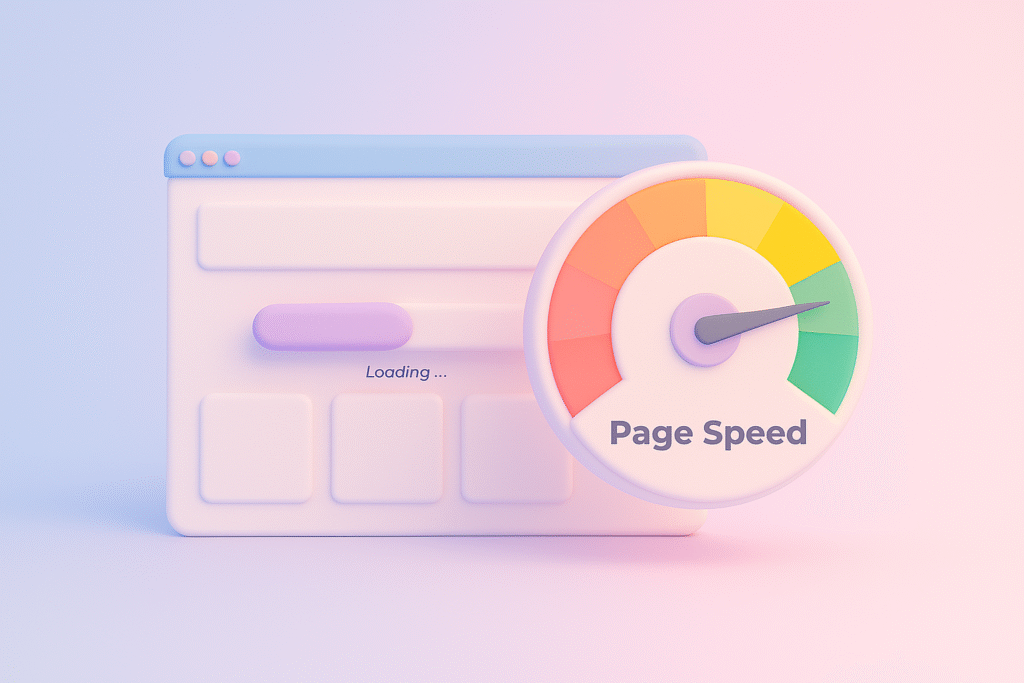When most of us think about SEO, we immediately go to keywords, content, backlinks… all the usual suspects.
But here’s one thing that often flies under the radar (until it’s already hurting you): page speed.
How fast your website loads can quietly make or break your visibility in search results. We’ve seen sites with great content struggle to rank, simply because they’re too slow. And once you know that, it’s kind of hard to ignore.
Whether you’re running a small business or managing SEO for clients in a fast-paced market like Sydney, speed matters. Not just to Google, but to your actual visitors.
So let’s unpack it: what page speed means for SEO, how it affects the user experience, and what you can do to fix it if things are dragging.
Why Page Speed Really Matters
Think about your own browsing habits. If a page takes more than a couple of seconds to load, are you sticking around?
Probably not.
Google feels the same way. Its entire job is to deliver fast, helpful, frustration-free experiences. And when a site loads slowly, that’s a red flag.
Here’s why speed affects SEO more than you might think:
- Google literally uses it as a ranking factor
- High bounce rates from slow sites = lower rankings
- With mobile-first indexing, mobile speed often weighs more than desktop
- And slower load times directly affect conversion rates
It’s not just about crawling and indexing anymore; it’s about whether your site is worth the user’s time.
Some Numbers That Might Surprise You
Still not convinced speed matters that much?
Here are a few stats from Google’s own research that might make you flinch:
- 53% of mobile users will ditch a site if it takes more than 3 seconds to load
- A 1-second delay can lead to a 7% drop in conversions
- Pages that load in under 2 seconds perform best, hands down
It’s kind of wild when you think about how much impact a single second can have. One second! That’s the difference between making a sale and losing a potential customer to someone else’s faster site.
How Google Actually Measures Speed
Google doesn’t just guess whether your site is fast; it uses real tools and real metrics. And if you’ve never looked into them, they’re worth understanding:
1. Core Web Vitals
These are Google’s three golden metrics:
- LCP (Largest Contentful Paint): How long it takes for the biggest thing on your page to load, like a hero image or block of text.
- FID (First Input Delay): How fast your site reacts when someone clicks or taps.
- CLS (Cumulative Layout Shift): How much the content shifts around while loading (you’ve seen this – when buttons jump just as you try to click them).
Google expects you to meet certain thresholds for each of these. If you fall short, your rankings could take a hit, even if everything else is great.
2. PageSpeed Insights & Lighthouse
These are tools you can run for free. They analyse your site, give you a score, and break down what’s helping or hurting your load time. Lighthouse is actually built into Chrome’s DevTools if you want to test from your own browser.
3. Mobile vs. Desktop Speed
This is a big one: Google prioritises the mobile version of your site for indexing. So if your mobile page is sluggish (even if your desktop version is fast), it still counts against you.
Not Sure If Your Site’s Slow? Here Are Some Clues
You don’t always need fancy tools to know something’s off. If you’re noticing any of the following, it might be time to investigate:
- Visitors are bouncing fast
- Mobile rankings are lagging behind desktop
- Clicking internal links feels… sticky
- Your competitors’ sites just feel quicker
- You are working with an SEO agency, but you never see page speed mentioned in your reports
Even a slight delay can add up over time, especially if you’re investing in traffic or paid ads. You are paying for clicks; don’t waste them on slow load times.
So… What’s Slowing You Down?
There are a bunch of possible reasons, but some issues pop up more than others:
- Oversized images (uploaded at full resolution, never optimised)
- Too many plugins or third-party scripts (especially on WordPress)
- Unminified JavaScript and CSS
- Weak or overcrowded hosting
- No browser caching
- No CDN (Content Delivery Network)
- Render-blocking resources that delay visible content from showing
You don’t need to be a developer to spot some of these. But if you’re not sure where to start, this is where working with a technical SEO agency really helps.
How to Improve Page Speed (Without Losing Your Mind)
This doesn’t have to be overwhelming. Here’s a step-by-step breakdown of the fixes that typically make the biggest impact:
1. Optimise Your Images
- Use formats like WebP or AVIF
- Compress before uploading (tools like TinyPNG are lifesavers)
- Don’t just resize in the page editor. Change the actual dimensions
2. Minify JavaScript, CSS, and HTML
- Strip out unnecessary spaces, comments, and bloat
- Tools like UglifyJS, HTMLMinifier, or Autoptimize (for WordPress) can help
- Smaller code = faster load
3. Set Up Browser Caching
- Caching helps returning visitors load your site faster
- Set expiry headers for static files
- Use a caching plugin if you’re on WordPress, like W3 Total Cache
4. Use a CDN
- A Content Delivery Network stores your content across multiple servers worldwide
- Makes a big difference if your audience is spread out geographically
- Try Cloudflare, BunnyCDN, or StackPath
5. Upgrade Your Hosting
- Cheap shared hosting can throttle your performance
- Consider cloud hosting or a VPS if traffic is growing
- Many SEO companies (especially local ones in Sydney) have hosting partners they trust
6. Defer or Asynchronously Load Scripts
- Not everything needs to load immediately
- Defer non-essential JavaScript and CSS
- This reduces “render-blocking” issues
7. Minimise Redirects
- Every redirect adds a bit of wait time
- Use a tool like Screaming Frog to audit your redirect chains
- Clean out the unnecessary ones
8. Use Lazy Loading
- Only load images and videos when they’re actually about to be seen
- Speeds up the first load significantly
- Built into most modern WordPress themes, or can be added manually
Tools Worth Bookmarking
Even if you’re not super technical, these tools can help you spot problems early:
- Google PageSpeed Insights – Easy to read, mobile + desktop scores
- GTmetrix – Great for visualising load sequence
- WebPageTest – Offers deep performance data
- Lighthouse – Built right into Chrome’s DevTools (just right-click > Inspect > Lighthouse tab)
They’re free, too. So, there’s no excuse not to check once in a while.
When to Bring in the Tech SEO Experts
You can make a lot of these changes yourself. But if you’re short on time, or just not into the technical stuff, that’s where an SEO agency can step in.
A solid agency will:
- Audit your site’s performance
- Handle all the code-level optimisation
- Keep an eye on Core Web Vitals
- Help you choose better hosting or a CDN
- Make sure your site aligns with the latest Google guidelines
Especially in a competitive local market like Sydney, having pros handle the backend while you focus on the front-facing stuff (content, strategy, conversion) can make a huge difference.
Final Thoughts
Today, search users don’t wait. Google doesn’t either.
If your site’s slow, it’s silently pushing people (and rankings) away.
But the good news? Page speed is something you can fix. Sometimes with a few tweaks. Sometimes with a full performance overhaul. Either way, the payoff is worth it: better rankings, happier users, and more conversions.
So, whether you’re fixing things yourself or teaming up with a good SEO agency, make page speed a priority. Your visitors (and your bottom line) will thank you.








